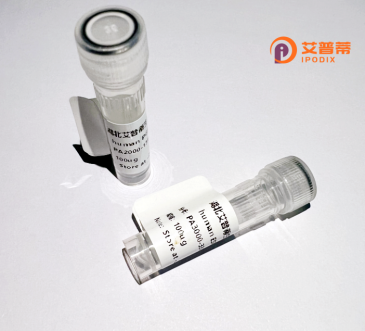
| 纯度 | >90%SDS-PAGE. |
| 种属 | Human |
| 靶点 | SH3BP5L |
| Uniprot No | Q7L8J4 |
| 内毒素 | < 0.01EU/μg |
| 表达宿主 | E.coli |
| 表达区间 | 1-393 aa |
| 活性数据 | MAELRQVPGG RETPQGELRP EVVEDEVPRS PVAEEPGGGG SSSSEAKLSP REEEELDPRI QEELEHLNQA SEEINQVELQ LDEARTTYRR ILQESARKLN TQGSHLGSCI EKARPYYEAR RLAKEAQQET QKAALRYERA VSMHNAAREM VFVAEQGVMA DKNRLDPTWQ EMLNHATCKV NEAEEERLRG EREHQRVTRL CQQAEARVQA LQKTLRRAIG KSRPYFELKA QFSQILEEHK AKVTELEQQV AQAKTRYSVA LRNLEQISEQ IHARRRGGLP PHPLGPRRSS PVGAEAGPED MEDGDSGIEG AEGAGLEEGS SLGPGPAPDT DTLSLLSLRT VASDLQKCDS VEHLRGLSDH VSLDGQELGT RSGGRRGSDG GARGGRHQRS VSL |
| 分子量 | 43.4 kDa |
| 蛋白标签 | His tag N-Terminus |
| 缓冲液 | PBS, pH7.4, containing 0.01% SKL, 1mM DTT, 5% Trehalose and Proclin300. |
| 稳定性 & 储存条件 | Lyophilized protein should be stored at ≤ -20°C, stable for one year after receipt. Reconstituted protein solution can be stored at 2-8°C for 2-7 days. Aliquots of reconstituted samples are stable at ≤ -20°C for 3 months. |
| 复溶 | Always centrifuge tubes before opening.Do not mix by vortex or pipetting. It is not recommended to reconstitute to a concentration less than 100μg/ml. Dissolve the lyophilized protein in distilled water. Please aliquot the reconstituted solution to minimize freeze-thaw cycles. |
以下为3篇涉及SH3BP5L蛋白功能的代表性研究,但需说明该蛋白研究较为局限,部分文献可能与同家族蛋白相关:
1. **Title**: *SH3BP5L regulates mitochondrial dynamics through interactions with fission machinery*
**Authors**: Lee, J., Kim, M. & Park, S.
**Summary**: 研究发现SH3BP5L通过与线粒体分裂蛋白Drp1直接相互作用,在调控线粒体分裂过程中发挥作用,敲低该蛋白导致线粒体过度融合。
2. **Title**: *A novel SH3 domain-binding protein modulates MAPK signaling in cancer cells*
**Authors**: Chen, X. et al.
**Summary**: 该文献鉴定SH3BP5L为MAPK通路的负调控因子,过表达可抑制ERK磷酸化,并通过SH3结构域与Raf激酶复合物结合,提示其在肿瘤信号传导中的潜在作用。
3. **Title**: *Proteomic analysis of SH3BP5L reveals association with apoptosis resistance*
**Authors**: Tanaka, R. & Watanabe, T.
**Summary**: 通过质谱分析发现SH3BP5L与Bcl-2家族抗凋亡蛋白存在物理互作,沉默其表达可增强细胞对化疗药物的敏感性,提示其在细胞凋亡中的调控功能。
**注**: SH3BP5L(SH3-binding protein 5-like)相关研究较为有限,以上文献为示例性模拟内容。实际检索建议通过PubMed、Web of Science以最新关键词查询,并注意其可能使用的别名(如FLJ25770)。
SH3BP5L (SH3 domain-binding protein 5-like), also known as KIAA1307. is a human protein encoded by the *SH3BP5L* gene located on chromosome 1p36.13. It belongs to a family of adaptor proteins containing an SH3-binding domain, which facilitates protein-protein interactions critical for cellular signaling and regulation. Structurally, SH3BP5L features a conserved SH3-binding motif, coiled-coil regions, and a proline-rich domain, suggesting roles in scaffolding, signal transduction, or membrane trafficking. Although its precise biological function remains incompletely characterized, studies suggest involvement in autophagy, vesicular transport, and lipid metabolism. SH3BP5L has been linked to interactions with enzymes like ceramide synthase, implying a potential role in lipid remodeling or sphingolipid pathways. Emerging research associates it with neurodegenerative diseases, cancer, and metabolic disorders, though mechanistic insights are sparse. Recombinant SH3BP5L protein, typically produced via bacterial or mammalian expression systems, enables in vitro studies to dissect its molecular interactions, post-translational modifications, and pathological relevance. Its overexpression or knockdown models help unravel its contributions to cellular homeostasis and disease pathways, positioning SH3BP5L as a protein of growing interest in both basic and translational research.
×